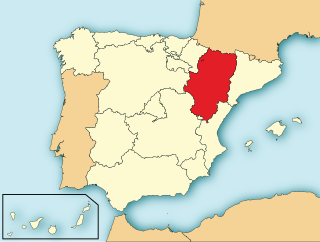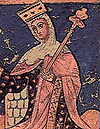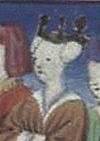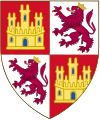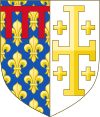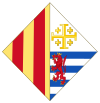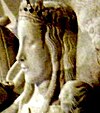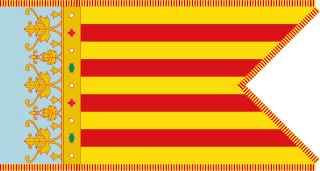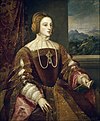Leonora of Castile or Eleanor of Castile may refer to:

Joanna, known historically as Joanna the Mad, was Queen of Castile from 1504, and of Aragon from 1516. Modern Spain evolved from the union of these two crowns. Joanna was married by arrangement to Philip the Handsome, Archduke of the House of Habsburg, on 20 October 1496. Following the deaths of her brother, John, Prince of Asturias, in 1497, her elder sister Isabella in 1498, and her nephew Miguel in 1500, Joanna became the heir presumptive to the crowns of Castile and Aragon. When her mother Queen Isabella I of Castile died in 1504, Joanna became Queen of Castile, while her father, King Ferdinand II of Aragon, proclaimed himself 'Governor and Administrator of Castile'. In 1506 Archduke Philip became King of Castile jure uxoris, initiating the rule of the Habsburgs in the Spanish kingdoms, and died that same year. Despite being the ruling Queen of Castile, she had little effect on national policy during her reign as she was declared insane and imprisoned in Tordesillas under the orders of her father, who ruled as regent until his death in 1516, when she inherited his kingdom as well. From 1516, when her son Charles I ruled as king, she was nominally co-monarch but remained imprisoned until her death.

John III was jure uxoris King of Navarre from 1484 until his death, as husband and co-ruler with Queen Catherine.

Germaine of Foix was queen consort of Aragon as the second wife of Ferdinand II of Aragon, whom she married in 1506 after the death of his first wife, Isabella I of Castile in 1504.

Juana Manuel of Castile was Queen consort of Castile from 1369 until 1379. She also was the heiress of Escalona, Villena, Peñafiel and Lara, as well as Lady of Biscay.

The Crown of Castile was a medieval state in the Iberian Peninsula that formed in 1230 as a result of the third and definitive union of the crowns and, some decades later, the parliaments of the kingdoms of Castile and León upon the accession of the then Castilian king, Ferdinand III, to the vacant Leonese throne. It continued to exist as a separate entity after the personal union in 1469 of the crowns of Castile and Aragon with the marriage of the Catholic Monarchs up to the promulgation of the Nueva Planta decrees by Philip V in 1715.
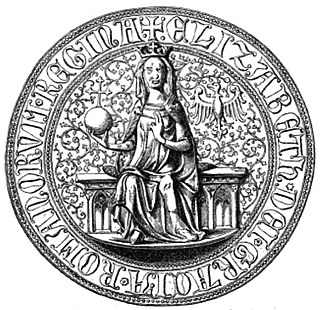
Isabella of Aragon was the daughter of James II of Aragon and his second wife Blanche of Anjou. Queen consort of Frederick I of Austria. She was a member of the House of Aragon

Ferdinand II, called the Catholic, was King of Aragon from 1479 until his death. In 1469, he married Infanta Isabella, the future queen of Castile, which was regarded as the marital and political "cornerstone in the foundation of the Spanish monarchy". As a consequence of the marriage, in 1474 he became de jure uxoris King of Castile as Ferdinand V, when Isabella held the crown of Castile, until her death in 1504. At Isabella's death the crown of Castile passed to their daughter Joanna, by the terms of their prenuptial agreement and Isabella‘s last will and testament, and Ferdinand lost his monarchical status in Castile. Joanna's husband Philip became de jure uxoris King of Castile, but died in 1506, and Joanna ruled in her own right. In 1504, after a war with France, he became King of Naples as Ferdinand III, reuniting Naples with Sicily permanently and for the first time since 1458. In 1506, as part of a treaty with a France, Ferdinand married Germaine of Foix of France, but Ferdinand's only son and child of that marriage died soon after birth. In 1508, Ferdinand was recognized as regent of Castile, following Joanna's alleged mental illness, until his own death in 1516. In 1512, he became King of Navarre by conquest.
Isabella of Aragon may refer to:
This article is of the Countesses of Dreux; the consorts of the French counts of Dreux.

The Infantes of Aragon is an appellation commonly used by Spanish historians to refer to a group of 15th-century infantes (princes) of the House of Trastámara, specifically the sons of King Ferdinand I of Aragon and his wife Eleanor of Alburquerque:
This page is based on this
Wikipedia article Text is available under the
CC BY-SA 4.0 license; additional terms may apply.
Images, videos and audio are available under their respective licenses.

